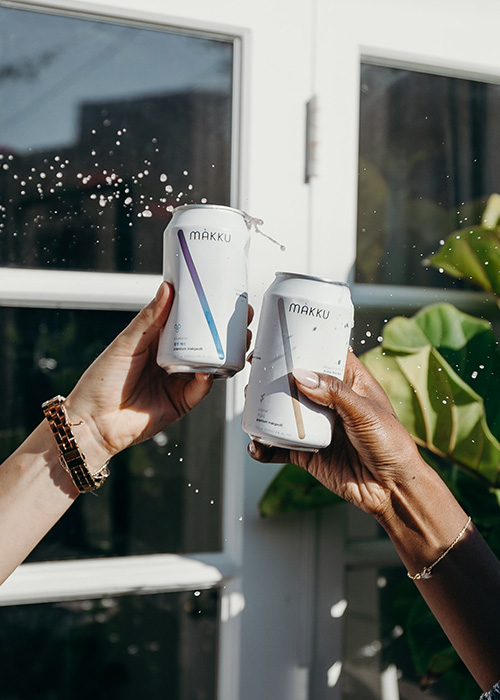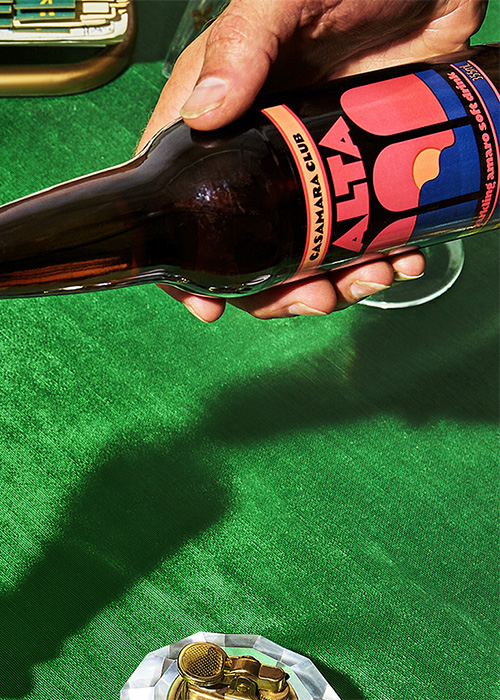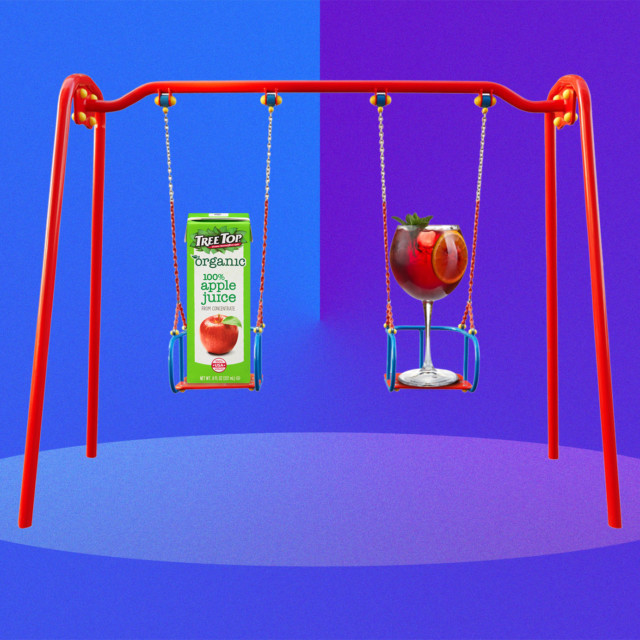“Is it cocktail hour yet?”
When my 4-year-old daughter shouted this across the playground late last summer, I didn’t know whether to be relieved (now I wouldn’t have to pry her away from the swings) or mortified (was I being judged by my fellow parents)?
I felt a momentary twang of embarrassment, not only because of the side-eye I felt from the other moms, but because I started to question how much I looked forward to cocktail hour, a new family tradition initiated by my husband. At 5 o’clock or so, everyone got their beverage and we enjoyed them together on the porch. My husband’s go-to was vodka, grape juice, and a splash of cranberry. I gravitated to whatever I felt like making in the moment now that I had some extra time to shake or stir a proper drink and meddle with garnishes and fresh juices. Our 4-year-old daughter got in on the fun too, asking for apple juice with a splash of cranberry juice or grape juice with rose syrup in a special cup (even though, in the “before times,” we didn’t regularly stock juice at home).
Like many Americans, my drinking had intensified with the pandemic. It’s not really surprising that alcohol consumption increased during the pandemic. When the pandemic and lockdown measures set in, it felt like a free-for-all. Nobody knew how long this was going to last or what we were in for, and people approached stocking up with the same gusto as preparing for a blizzard or hurricane, ransacking store shelves for canned beans and toilet paper (if you could find it), and stockpiling alcohol. But as the pandemic rages and we are staring down the Delta variant, it’s time to reexamine our culture’s collective psyche as one that normalizes drinking as a coping mechanism masquerading as self-care instead of a pleasure to enjoy recreationally and in moderation.
According to the IWSR Drinks Market Analysis, total beverage alcohol volume in the U.S. in 2020 was up 2 percent, marking the largest gain for alcohol consumption since 2002 (though IWSR also notes that, pre-Covid, many beverage alcohol categories were already growing by volume and value, largely due to the fact that the U.S. volume share of alcohol sales is 80 percent off-premise, or at-home consumption, and 20 percent on-premise, or out-of-home.)
There is evidence that suggests Americans should be drinking more moderately. In December 2020, the revised federal 2020-2025 Dietary Guidelines for Americans recommended that “adults of legal drinking age can choose not to drink, or to drink in moderation by limiting intake to two drinks or less in a day for men or one drink or less in a day for women, on days when alcohol is consumed.” That’s a 12-ounce beer (5 percent ABV, or alcohol by volume), a 5-ounce glass of wine (12 percent ABV), or 1.5 ounces of a distilled spirit (40 percent ABV). The Guidelines recommend these limits as a way to reduce risk of alcohol-related harm, including several types of cancer and some forms of cardiovascular disease.

When I started to assess my own consumption levels, I realized that I looked forward to that drink to mark the end of another day in a stretch of time in which the days too often blurred together. But adding that cocktail to my usual glass of wine with dinner meant I was drinking twice as much as I usually did. (Plus, my tolerance isn’t what it used to be pre-motherhood, after nine months abstaining during pregnancy, and seldomly drinking throughout 15 months of breastfeeding.)
By early fall 2020, after about six months of this daily routine, I started to notice changes in my energy levels, weight, and mental focus. I took longer to get going in the morning, my clothes didn’t fit the same (even my yoga pants), and I snapped more frequently at my daughter. I chalked part of this up to the pandemic-induced brain fog and general sense of malaise that seemed to plague us all. But I could tell by the morning sluggishness and headaches that alcohol was partly to blame.
I decided to make changes to my consumption (the novelty of shaking up a perfect Negroni à la Stanley Tucci had worn off anyway), instead opting for an easy Campari spritz with fresh citrus juice. From there I researched low-alcohol options in hopes of taking steps to moderate my consumption and hopefully discover something new to me and delicious. I was aware that low ABV meant beverages containing a lower percentage of alcohol, but I didn’t realize that there were so many options.
“Pre-Covid, low- and no-alcohol categories were already growing, and the pandemic has not slowed this trend,” Brandy Rand, IWSR COO of the Americas, says.
IWSR forecasts that the low- and no-alcohol market in the U.S category will grow by a 23.5 percent compound annual growth rate (2020 to 2025). IWSR’s definition of low ABV varies by category — for example, 0.5 to 3 percent for Ready to Drink (RTD), up to 3.5 percent for beer, and up to 7.5 percent ABV for still or sparkling wine. No-alcohol is defined as 0.0 to 0.5 percent ABV across all categories.
Rand says that the low-ABV trend is primarily driven by the beer and RTD categories. And while sessionable and “fitness” beers are most widely marketed for their lower ABV, she notes that no-alcohol beer is the key driver, accounting for 90 percent of total U.S. low- and no-alcohol category volume share. The other categories — low- and no-alcohol wine, RTDs, and spirits — make up 10 percent. According to recent IWSR research, the male/female split for no- and low-alcohol products is fairly even, though women do skew more toward no- or low- alcohol wine (53 percent female versus 47 percent male) and RTDs (53 percent female versus 47 percent male). But overall, the low-ABV category growth hasn’t emerged solely because of the pandemic. Although for context, it’s important to note that low- and no-alcohol beverages’ market share is still quite small; the volume in 2020 was 25 million cases.
“This is much more of a health and wellness lifestyle trend that has extended beyond the initial periods of Dry January and is much more integrated into a balanced lifestyle that can include both low/no alcohol and alcohol,” Rand says.
In other words, consumers are not choosing alcohol or no- or low-ABV, but rather alternating between the two categories throughout the week or during one occasion. This feels much more in line with how I personally want to consume alcohol, as a mom, as someone who is trying to take the reins of their physical and mental health, and as someone who still places a premium on well-crafted, delicious-tasting beverages.
One of the perks of being in the food and beverage industry is that you have colleagues to turn to for all kinds of recommendations. Thanks to an industry friend, I discovered Jus Jus, a low-alcohol sparkling wine co-founded by Julia Sherman, author of the books “Salad for President” and “Arty Parties.” While on a book tour for her first book, she opened a bottle of verjus to cook with and, to her surprise, found that it had fermented.
“It tasted delicious, like a dream sparkling wine experience,” Sherman says. Not long after, she started drinking less in hopes of creating a more optimal environment in her body for getting pregnant. She found herself wishing there was something on the market like that dreamy sparkling wine. She wanted something handmade and with a sense of place, something that could create a “beautiful experience, but not get me wasted.”
Sherman partnered with winemaker Martha Stoumen and, in 2019, launched the first vintage of Jus Jus, featuring a blend of California Chardonnay and Muscat blanc lightly fermented in the style of a Pét-Nat, with no added sulfites or preservatives. The wine has a 3.5 percent ABV, about a quarter the amount of alcohol of sparkling wine. In 2020, Jus Jus released two vintages; the original 3.5 percent ABV was rebranded as Day, and the other, Night, has a 7 percent ABV and is drier.
Sherman loves the idea of being able to have two glasses of Jus Jus Day during afternoon drinking, say at a festive brunch or baby shower. Often, she uses it as a base ingredient for a spritz, pairing it with Lillet or Cocchi Americano, yielding a beverage with a 5 percent or 6 percent ABV. Sherman says that for people who like having two glasses of wine in an evening, but for whom the average alcohol percentage poses the threat of feeling drunk or a hangover, Night offers a more moderate way to consume two glasses of wine.
Another perk of being a food and beverage writer is getting to sample new-to-me beverages or new releases. It’s how I discovered Màkku, a brand of canned makgeolli, or makkuli, Korea’s oldest alcoholic beverage, made with rice, nuruk (a traditional fermentation starter), and water. Màkku launched with three flavors — original, blueberry, and mango — and recently added passion fruit. Two online exclusive flavors, strawberry and lychee, launched mid-August. I’m partial to the original flavor: It’s creamy in body, refreshing, and slightly tart, with a distinct earthiness from the rice and a touch of sweetness. At 6 percent ABV, Màkku technically isn’t considered low alcohol, but the product is in line with emerging market trends for ready-to-drink (RTD) canned alcoholic beverages.
Before launching Màkku, in late 2019, Carol Pak worked for ZX Ventures, the global investment and innovation arm of Anheuser-Busch InBev. “2016 was an important year for beverage because it seemed like an inflection point where we were seeing a decline in the growth of craft beer and then we were starting to see new, emerging alternative alcoholic beverages,” Pak says, crediting the advent of hard cider and ensuing hard seltzer craze for kickstarting the trend toward more health-conscious drinking.

I love the notion of calling the low-alcohol category “alternative alcoholic beverages,” especially since many consumers don’t know what ABV stands for, low or otherwise. Rather than market Màkku as low-ABV and knowing that it most closely fell into the beer category, Pak opted to bill it as a sessionable Korean rice beer. “We knew it would become a thing where people would be able to casually drink multiple cans,” she says. “At that time, sessionable was more around 5 percent, but we just felt like it tasted better at 6 percent.”
In addition to low-alcohol beverages, I’ve also begun researching no-alcohol options and have even discovered a couple that are in regular rotation at home. I was floored at the complexity of Curious Elixir’s booze-free cocktails, particularly the No. 2, a riff on a Dark and Stormy whose spicy-tart flavor profile lands it somewhere between a pineapple Margarita and a Moscow Mule.
Some nights, when I feel the desire for an aperitif sans alcohol, I turn to Casamara Club’s sparkling amaro sodas. I especially love Onda, a refreshing, earthy number infused with extracts of lemon, sage leaf, rhubarb root, Italian Chinotto, juniper berry, and anise, all balanced with a refreshing acidity from lemon juice, a touch of sweetness from Demerara sugar, and a lush salinity from a touch of Mediterranean Sea salt. And while I’m not much of a beer drinker, I must admit that I’m curious about those no-alcohol beers that are driving the low-ABV category’s growth; I just might have to try one for myself.
